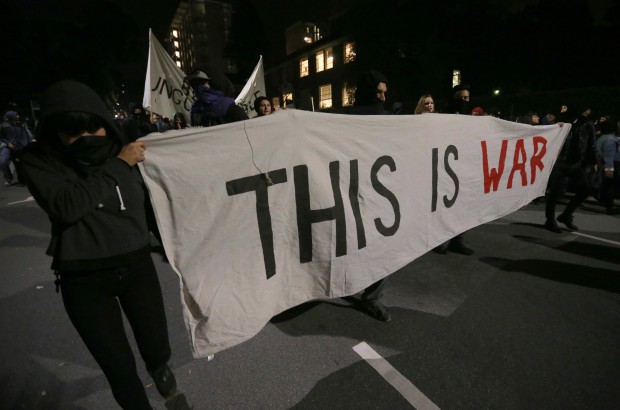Filed under: Analysis, Anti-fascist, Capitalism, Critique, Repression, The State, US

“Never were we freer than under the German occupation.”
–Jean Paul Sartre, “Paris Alive,” 1944
It is impossible not to notice the foreboding and despair many people express as they witness the first months of Trump’s presidency. The list of grievances grows longer with each passing day, and make no mistake, there are real human consequences to every appointment, executive order, and tweet.
Based on the title, you would be forgiven for thinking this article may bring a message of hope in spite of such despair. But while I am going to offer a different perspective on what is happening, I am wary of that brand of cruel optimism that leads to complacency. To be clear from the outset, what I’m arguing here is that even as we are right now seeing the beginnings of a dark and apocalyptic future, we are also closer to realizing a massive social revolution than ever before. The difference between these two alternatives is in our ability to rise up and fight like our lives depend on it, because our lives really do depend on it.
The perspective I am offering here, which is somewhat counter-intuitive, is the perspective from below. Much of the analysis of the Trump train wreck looks down from above. The perspective from above takes the elite point-of-view and understands the world through a lens of authority. Trump did this, Bannon did that, Spicer said this, and Conway said that. Clinton responded, Merkel explained, and Trudeau lamented. These powerful individuals are, in the view from above, the movers of politics and the shapers of our collective destiny. All us plebs are basically inert, a field of grain before the reaper.
The view from the grassroots, on the other hand, sees all of us regular folks, the whole multitude and mass of us around the globe, as the prime movers of history. For a long time, we have been trying to carry out a social revolution, a fundamental shift with respect to how we live and how we experience the world. But those with the most power and those with the most wealth have opposed us at each step. Every time even a hint of the social revolution comes to the surface, those with economic and political power react. The reactionaries come forward and do whatever it takes to maintain the system that benefits the wealthy and powerful. They also do whatever they can to make us forget the social revolution is even possible.

The system these reactionaries are fighting to maintain is difficult to clearly define. Some call it “the machine” and some call it “empire” and it has many other names as well. It doesn’t have one person at the top calling the shots and there is no shadowy conspiracy pulling the strings. The system is not controlled by any one state and it is not reducible to the vast and unaccountable corporate matrix that enmeshes the globe. The system is all the different nodes and collections of power interacting. And even though the people who benefit most from the system have their internal differences and disagreements, and even though they only vaguely perceive or understand the emergent social revolution, they are nonetheless united in their opposition to it because it threatens to overturn their wealth and power.
As I see things, the recent surge of fascism is precisely a defense mechanics of the system as it desperately tries to keep down the social revolution. Historically, the system has used other remedies and adapted in various ways to maintain itself. Fascism is what the system turns to when other mechanisms don’t work. The Trump presidency in the United States provides a vivid example of this last ditch reactionary mechanism, but similar fascistic tendencies are evident everywhere. The important point to note is that the only reason we are seeing fascism is because the social revolution is presently so dangerous to the system.
A brief and necessarily incomplete historical overview of the 20th and early 21st century from the grassroots point-of-view helps back up the claims I am making, but I want to stress that none of this is as clear-cut as I am presenting it. I encourage interested readers to view some of the linked materials for more detail or to do some background reading.
How we got here
In the first two decades of the 20th century, a wave of revolutionary fervor swept through Europe, culminating in the 1917 Russian Revolution. I see the numerous apparently disconnected uprisings that took place in this period as attempts at a broader social revolution. Even though upon seizing power the Bolsheviks actually snuffed out the revolution, the Russian Revolution and the revolutionary wave leading up to it inspired fear in those with economic and political power in the European states. Both Mussolini’s and Hitler’s fascisms arose in direct opposition to the social revolution. In order to gain traction, these fascist leaders usurped the desire for social revolution and channeled it into their reactionary movements.
Although those with wealth and power did not necessarily like everything about the fascists, their desire to maintain the system meant they supported the fascists (or at least tolerated them). An example of this was during the 1936 Spanish Revolution. Spanish peasants and industrial workers rose up and enacted the revolution in huge swaths of the country. This was perceived as such a threat to those who held political and economic power that they supported the combined forces of Franco’s fascists, Hitler’s fascists, and Mussolini’s fascists in crushing the revolutionaries. The fascists were enabled or appeased, openly or tacitly, by capitalist democratic states including Britain, France, and the United States (even Stalinist Russia played a part in crushing the revolution). In fact, fascism was popular with wealthy and powerful people all over the world in the 1920s and ‘30s because it offered a remedy to mounting social unrest.
Of course, the fascist states were defeated in World War II, but not before they fulfilled their role of putting down the social revolution and facilitated the disciplining of revolutionary populations. This was accomplished in a few ways: the fascist armies physically attacked revolutionary populations; capitalist democracies militarized their own populations for war, creating a context in which agitation for revolution was seditious; and whole countries and their industries were destroyed and needed to be reconstructed after the war, which helped stave off further calls for revolution.
In the decades after World War II, the system was arguably somewhat better at adapting whenever it was under threat. It was able to tinker with the machinery or replace a faulty part and keep going without turning to widespread fascism (though there continued to be fascism and fascist governments throughout the world, often as a reaction to revolutionary movements). Generally, the system worked well enough and provided enough benefits that there was less unrest than in the revolutionary decades that opened the 20th century.

Oil and the defeat of organized labor
The industrial base of the system was also reorganized around oil as a principle energy source, which played a part in diminishing the strength of industrial labor. In the earlier half of the century, organized labor was a key factor in revolutionary movements and was able to exert significant leverage over industries when coal was the primary energy source. The oil industry, because its products were transported by sea and because of other characteristics, was less susceptible to strikes and blockades. At the same time, those with economic and political power also used a number of other strategies to diminish the strength of organized labor.
I want to pause for a moment and note that by focusing on the oil industry and organized labor I am in no way trying to diminish the importance of other struggles. My view is that seemingly distinct struggles, while retaining important differences, very often intersect and build upon one another. That said, the oil industry provides a good example of how the system tried to adapt to social unrest and imbalance. The question of oil is also intimately bound up in any speculation on the future.
Specifically, one example of the system adapting to unrest and to pressure was in response to the 1970s oil shocks. Industrialized Western countries were thrown into an economic tailspin by the oil shocks, and feared they would not be able to meet domestic demand for energy, thus leading to social unrest. The United States was apparently preparing in 1973 to invade Saudi Arabia and other countries in the Middle East to ensure that the oil kept flowing, such was the threat posed by the OECD embargo.
The system’s adaptation to the oil shocks was to liberalize global trade and commerce, and to continue the attack on organized labor, through the doctrines of neoliberalism. Neoliberal policies created enormous wealth and an economic boom in industrialized Western countries. At the same time, multinational companies took advantage of cheaper sources of labor in developing countries, which further hollowed out the power of organized labor at home. All of this was agreeable to those with political and economic power.
However, even as neoliberalism was a successful adaptation by the system, it also created new problems. It spawned an out of control financial sector and amped-up forms of predatory capitalism that ravaged the developing world. The rapaciousness of globalized neoliberal capitalism precipitated the 2008 financial crisis, which announced to everyone that neoliberalism had failed. In the wake of the financial crisis, a wave of revolutionary energy emerged, notably in the Arab Spring and uprisings throughout the globe that continue to today.
Neoliberalism was also, like the earlier form of industrial capitalism, based on the absurd premise of cheap, plentiful oil at the very time the environmental movement started to sound the alarm bell about the impacts of carbon emissions and climate change. The oil industry had also expanded with respect to its physical geography, such that pipelines, well pads, and other infrastructure encroached on communities, and many of these communities began to resist. The aftermath of the 2008 financial crisis, the oil implicated climate crisis, and resurgent calls for revolution: this brings our brief history to a close and to the world we inhabit today.
 Where we are now
Where we are now
Like in the past, powerful economic and political interests, though no more a united or homogeneous group other than a desire to maintain the system, see the threat posed by the emergent social revolution. The system tried to adapt and recuperate itself through green capitalism, but it hasn’t worked (or at least hasn’t worked fast enough). Part of the reason the system is unable to adapt, arguably, is that the end of oil necessarily means the end of the system itself. It is no coincidence that even as some industries (like tech, service, and public sector) are currently kicking up a fuss over Trump, the oil industry is one of his staunch supporter. Trump promises to remove regulations and scrap policies to limit carbon emissions, which breathes new life into a limping oil industry.
But note that none of the things that Trump and Co. are doing actually help the system to address the underlying causes of growing unrest. For the last seventy or so years, the system has been reasonably good at adapting, but since it recently is unable to do so the threat of social revolution re-emerged. In this context, it should not be surprising to see that last ditch mechanism, fascism, coming back. Just as before, fascism attempts to recruit the desire for social revolution for its own reactionary ends. This fascist reaction may not be entirely desirable to those with political and economic power, but they will ultimately accept it rather than have the system they benefit from collapse.
However, what I want to stress once again is that the only reason we are seeing fascism is because the social revolution is presently so dangerous to the system.
All of the uprisings and all of the struggles of the past century have brought us here. We, the many, have all along been the authors of history, while those few with political and economic power have worked hard to keep us down, to keep us from realizing our revolutionary task. What has been happening all along is our molecular action from below, pulverizing the foundations of the system, such that now it teeters on the brink of collapse. In the coming months and years, we have an unprecedented opportunity to carry out a massive social revolution and rebuild the world in the image of the many, instead of the present system built on the vanity of a few.
This paradigm shift will be opposed by the present system and its reactionaries, who are quickly turning vicious. It is a beast that is wounded and desperate, and we want to overcome it without everything being destroyed that may be useful after the revolution. And it needs to be said that there is certainly no guarantee we will be victorious – if history is any indication, we are as likely not to be. So even as this is as close to the social revolution as we have ever been, at least since 1917, we need to fight like hell in the name of a decent and livable future and lay this system of domination to rest.





